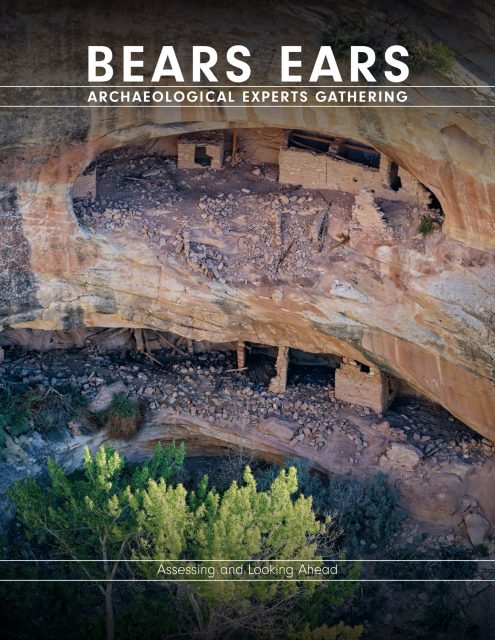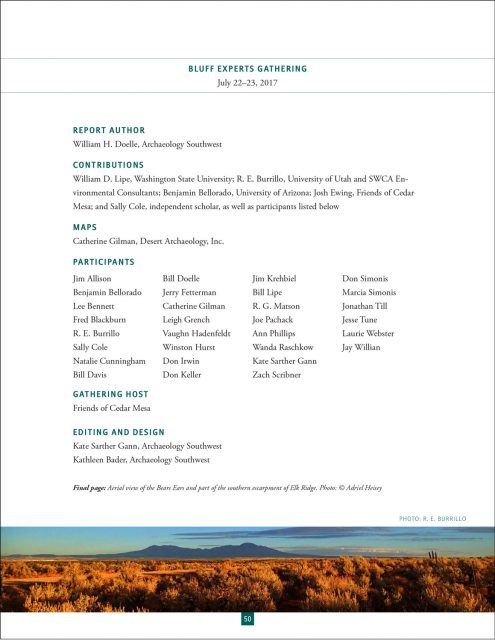- Home
- >
- Press Releases/Announcements
- >
- What’s at Stake If Protections Are Eliminated fo...
Public report shows that Antiquities Act more than applies to landscape-scale Bears Ears National Monument
Tucson, Ariz. (August 24, 2017)—On July 22 and 23, 2017, a group of 29 archaeologists, historians, and related experts came together in Bluff, Utah, to share their knowledge about people’s lives in the Bears Ears National Monument in the past. Archaeology Southwest and Friends of Cedar Mesa worked in close partnership to organize and implement this gathering of experts. The result, one month later, is a free report geared to public audiences. This pro bono effort is solely advisory. The Bureau of Land Management, U.S. Forest Service, and Bears Ears Tribal Commission are in the initial stages of drafting a management plan for the new national monument.
Download the report (free PDF)
The experts who attended the two-day session acknowledged the monument’s existence, and its controversial status was not the topic of conversation. Instead, the conversation went like this: what is our cumulative knowledge about this place? And what don’t we know that we would like to? What is an appropriate focus for future research? How might archaeologists help plan for a dramatic increase in visitors? How might we help to provide improved interpretation of the resources of Bears Ears? How might we work with tribes, agencies, other archaeologists, and the public to make Bears Ears a success?
“Archaeology Southwest often uses expert-guided planning sessions to develop strategies for protecting archaeological sites across large landscapes. The key to success is to have everyone focused on a real-time information display,” said Bill Doelle, President and CEO of Archaeology Southwest. “In Bluff, we gathered in the community center, where attendees were arrayed at tables facing a large screen, and we projected maps on that screen from a computer equipped with a geographic information system, or GIS. Mapmaker Catherine Gilman literally adjusted maps on the fly.”
Although Archaeology Southwest provided general facilitation, individual experts led discussion about an area they knew well, and then all others had an opportunity to comment or add information. Bluff-based Friends of Cedar Mesa hosted the event.
The resulting public report is an amazing example of what true collaboration might produce. The report considers the many ways in which past cultural landscapes are reflected within and beyond the new national monument.
|
|
“Just one month after the sessions, we have this reader-friendly document that conveys the broad-consensus opinions of experts to the interested public,” said Doelle. “And the report acknowledges that a national monument such as Bears Ears presents a powerful opportunity for tribes and other stakeholders to collaboratively manage and interpret a rich and living landscape of interrelated places.”
About Archaeology Southwest
Archaeology Southwest is a private 501(c)(3) nonprofit organization based in Tucson, Arizona, that explores and protects the places of our past across the American Southwest and Mexican Northwest. For three decades, Archaeology Southwest has fostered meaningful connections to the past and respectfully safeguarded its irreplaceable resources. Learn more at www.archaeologysouthwest.org.
About Friends of Cedar Mesa
Friends of Cedar Mesa is a conservation-focused 501 (c)(3) nonprofit organization based in Bluff, Utah. Mark Meloy, a former BLM employee, founded FCM in 2010. Friends of Cedar Mesa works to ensure that the public lands in San Juan County, with all their cultural and natural values, are respected and protected. Learn more at friendsofcedarmesa.org.

